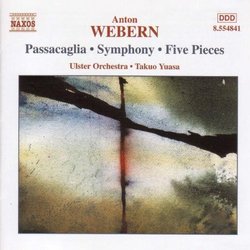| All Artists: Anton Webern, Takuo Yuasa, Ulster Orchestra Title: Webern: Passacaglia, Symphony, Five Pieces Members Wishing: 0 Total Copies: 0 Label: Naxos Original Release Date: 1/1/2002 Re-Release Date: 1/15/2002 Genre: Classical Styles: Chamber Music, Historical Periods, Modern, 20th, & 21st Century, Symphonies Number of Discs: 1 SwapaCD Credits: 1 UPC: 636943484128 |
Search - Anton Webern, Takuo Yuasa, Ulster Orchestra :: Webern: Passacaglia, Symphony, Five Pieces
 | Anton Webern, Takuo Yuasa, Ulster Orchestra Webern: Passacaglia, Symphony, Five Pieces Genre: Classical
|
Larger Image |
CD DetailsSimilar CDs |
CD ReviewsPost-Romantic Webern Thomas F. Bertonneau | Oswego, NY United States | 04/12/2002 (4 out of 5 stars) "Takuo Yuasa, conductor of the Ulster Orchestra, takes for granted a judgment that rarely occurs to the advocates of Anton Webern (1883-1945): that Webern was, above all else, a Romantic, as his devotion to the music of Gustav Mahler might have indicated. What's that? Webern, a Romantic? The Romantics (Mahler typifies the phenomenon) worked on a large scale, employing a lavish palette. Well yes, but some of them - Mendelssohn and Schumann, to name but two - also wrote in miniature and excelled at it. Webernian aphorism, usually taken for the very form of the modern in music, has its direct antecedents in the "Songs without Words," "Bagatelles," and "Scenes" of the German mid-Nineteenth Century keyboardists. These pieces seek to evoke intense, shifting, transient emotions and images, as incidentally do Mahler's songs. Webern's Romanticism does not end, then, with his Passacaglia, Opus 1, of 1908; it merely becomes more concentrated, taking the form of brief, but intense atmospherics corresponding with contemporary developments in German poetry. (Indeed, at least half of Webern's oeuvre is vocal or choral, setting verses by poet-contemporaries like Georg Trakl and Hildegard Jone.) Take Webern's Symphony, Opus 21, of 1928; listen carefully to the opening bars. The orchestration should be familiar: strings, horn, and harp - the characteristic instrumentation of the opening Adagio of Mahler's Ninth Symphony. That it could be other than an allusion seems unlikely and since it therefore most probably is, we are entitled to ask, what is the meaning of it? At least one plausible "message" is to remind us that this music, for all its technical erudition and aesthetic compression, is in line with what has come before it, especially the gigantic, emotionally wide-spanned symphonies of Webern's idol, Mahler. The orchestral Variations, Opus 30, from 1940, look back to Brahms, Reger, and Hindemith - and of course to Bach. Yuasa plays both works (rightly) as though they were drenched with the pure distillate of pathos and emotion; this is definitely not the antiseptic Webern of, say, Robert Craft or of Pierre Boulez in his readings for CBS, now Sony. (Boulez's DG remakes are "warmer" than his CBS originals.) Yuasa's program sandwiches the Five Movements for Strings (Opus 5) from 1929, the Six Pieces for Orchestra (Opus 6) from 1909 (revised in 1928), and the Five Pieces for Orchestra (Opus 10) from 1911-13, between the Symphony and the Variations; he takes the Symphony and the Variations as parts of a diptych, a plausible decision considering that Webern originally intended at least two more movements for the Symphony and that the Variations share the Symphony's sound world. The Five Movements, arranged from string quartet originals, are quite moving and rich; they suggest Berg's later Lyric Suite in its string orchestra version. The performance of the Symphony competes with Christoph von Dohnanyi's, with the Cleveland Orchestra on London, for the best on disc; rather than isolated and transient "events," we get musical continuity. Herbert von Karajan played the Symphony notoriously slowly in his DG recording, stretching it out to about a quarter of an hour. Yuasa turns it in at a more "normal" eleven minutes. There is one minor complaint: at a mere fifty-two minutes, the Naxos program runs rather short; the Piano Concerto and the Concerto for Nine Instruments could certainly have been accommodated within the eighty-two minute limit of the format. Nevertheless, this is a fine entry in the Webern column of the CD catalogue, especially considering the bargain price." Compelling Webern Max Schmeder | New York, NY | 11/18/2008 (4 out of 5 stars) "The other reviewer is correct: the dynamics are extreme, and more so than Webern intended. But it's electrifying. To pick apart just one track, consider the first movement of the Symphony. Webern's dynamic range is never above a forte, yet you'd never know it from the explosions in the strings. Yuasa is clearly responding to the intensity of the growing crisis in the "development" section (put lots of quotes around that...). By contrast, other conductors gingerly highlight the bits and pieces, and fail to convey the long building arc.
Yet there are some serious problems. The bass clarinet comes in a measure too soon at 1:50 (m.22 during the second repeat of the A section leading into B). Why couldn't they clean this up??? Also, Yuasa runs roughshod over some of the solos in the second half of the movement. For example, the strange little harp solo at 2:22 (m. 33/34) goes *up* instead of *down*. I'm very partial to these two little notes, and again, one wonders why they didn't just do a retake. The harpist got it right the second time through. God knows, this is short enough music. Anyway, I love Yuasa's robust interpretation, but it's sloppy at times. Still, it's a refreshing contrast when you compare it to the standard myopic approach whose only merit is exactness. And no wonder Webern's music is treated by performers like gears and levers. There is that tired and ubiquitous platitude that his music is "economic." Recall that a similar belief produced mind-numbingly mechanical performances of Bach in the 50's and 60's. Why is "economic" always the first adjective to come to people's lips, even from people who should know better? Above all, it should be considered exquisite, exotic, arresting, and powerful. "..he inexorably kept on cutting out his diamonds, his dazzling diamonds, the mines of which he had such a perfect knowledge." (Stravinsky on Webern)" |

 Track Listings (20) - Disc #1
Track Listings (20) - Disc #1

